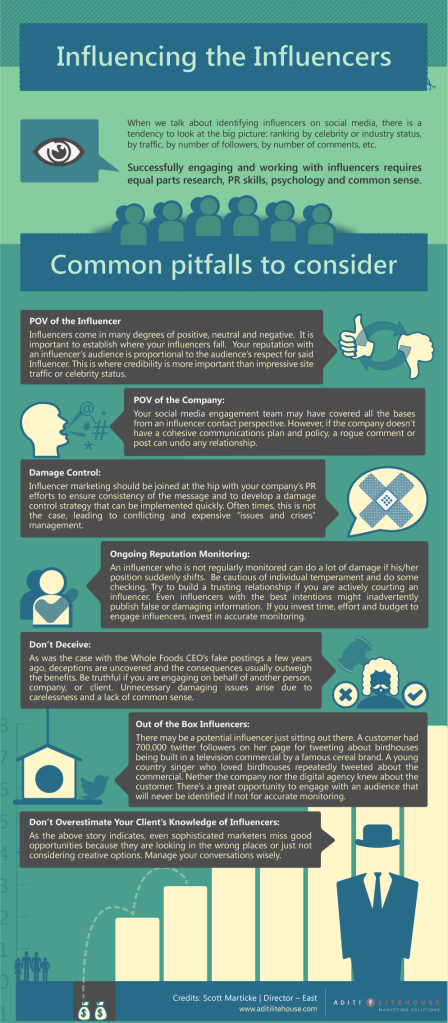Tag Archives: scott marticke
Influencing the Influencers
When we talk about identifying influencers on social media, there is a tendency to look at the big picture: ranking by celebrity or industry status, by traffic, by number of followers, by number of comments, etc. There are, however, several nuanced areas that need to be considered. Some of these may seem obvious, but are often ignored or poorly implemented. Successfully engaging and working with influencers requires equal parts research, PR skills, psychology and common sense.
What follows are several steps that should not be overlooked when developing a relationship with influencers. Considering one or more of these might just help you avoid some common communications pitfalls.
POV of the Influencer:
Influencers come in many degrees of positive, neutral and negative. It is important to establish where your influencers fall. Once objectively rated, the next step is to develop an intelligent plan to address each, strengthen the positive, shift neutral to positive and the negative to neutral. The consideration should be how to best approach or “influence” the influencers. Don’t just rush to contact, as some influencers may be open to it, but in some cases it can backfire. It is important to know who they are and what they are saying about you and your competition, even if contact is not advised.
In a sense, it’s like hiring an employee or a spokesperson. Your reputation with an influencer’s audience is proportional to the audience’s respect for said Influencer. This is where credibility is more important than impressive site traffic or celebrity status.
POV of the Company:
You need to fully understand the dynamics within the company you are representing. Your social media engagement team may have covered all the bases from an influencer contact perspective. However, if the company doesn’t have a cohesive communications plan and policy, a rogue comment or post can undo any relationship.
Damage Control
Influencer marketing should be joined at the hip with your company’s PR efforts to ensure consistency of the message and to develop a damage control strategy that can be implemented quickly. Often times, this is not the case, leading to conflicting and expensive “issues and crises” management.
Ongoing Reputation Monitoring:
Many, if not most, influencers are not contractually tied to those entities they influence. An influencer who is not regularly monitored can do a lot of damage if his/her position suddenly shifts. Be cautious of individual temperament and do some checking. Try to build a trusting relationship if you are actively courting an influencer. Even influencers with the best intentions might inadvertently publish false or damaging information. If you invest time, effort and budget to engage influencers, invest in accurate monitoring.
Don’t Deceive:
As was the case with the Whole Foods CEO’s fake postings a few years ago, deceptions are uncovered and the consequences usually outweigh the benefits. Be truthful if you are engaging on behalf of another person, company, or client. When BP tried to assuage the Gulf of Mexico oil spill, they posted a picture of their central damage control room. Almost immediately, the Internet was buzzing with graphic experts who pointed out that several of the computer screens appearing in the control room photo had manipulated images on them. Again, an unnecessarily damaging issue arose due to carelessness and a lack of common sense.
Out of the Box Influencers:
There may be a potential influencer just sitting out there. An example: Several years ago, a major manufacturer of breakfast cereals created a TV commercial featuring a man who builds birdhouses. I did an analysis of online comments and found a young country singer who had a passion for birdhouses and was repeatedly tweeting positive comments about the commercial and the product. No one at the manufacturer, ad agency or digital agency had heard of her, yet she had over 700,000 twitter followers, many of whom re-tweeted or commented positively on her posts. There’s a great opportunity to engage with an audience that will never be identified if not for accurate monitoring.
Don’t Overestimate Your Client’s Knowledge of Influencers:
As the above story indicates, even sophisticated marketers miss good opportunities because they are looking in the wrong places or just not considering creative options.
I worked at an ad agency (in the years leading up to online marketing) where we used a term, “The Backyard Fence Syndrome”. We would spend thousands of hours and millions of dollars launching an advertising campaign for a new client. A consumer would be exposed to TV ads, radio, print, direct mail, promotions, etc. We’d spend so much time and effort to establish our product on the consumer’s consideration set. Then, one comment by a neighbor over the backyard fence about how his “brother-in-law bought one and it was a lemon” and our potential buyer was lost. Today, that backyard conversation has gone global. The difference is you have the ability to manage it. Do so wisely.
– Scott Marticke
Director – East


